Written by CIMA interns, Olivia La Manna and Deborah Bosa
Two of the most famous art auction houses located in Manhattan are Christie’s and Sotheby’s. Christie’s is a British auction house. It was founded in 1766 by James Christie. Its main premises are on King Street, St James’s in London and in the Rockefeller Center in New York City. In New York Christie’s opened at first in Park Avenue during 1977, but later in 1997 the Company signed a 30-year lease on a 300,000 sq ft space in Rockefeller Center for $40 million. The Company has 85 offices in 43 countries, including New York City, Los Angeles, Paris, Geneva, Houston, Amsterdam, Moscow, Vienna, Buenos Aires, Berlin, Rome, South Korea, Milan, Madrid, Japan, China, Australia, Hong Kong, Singapore, Dubai, and Mexico City. Since 1744 Sotheby’s has housed some of the world’s most prestigious and desirable works of art. Originally opening in London, Sotheby’s became the first international auction house when it expanded to New York City in 1955. Today, they also have locations in Hong Kong and Paris. CIMA’s members had the opportunity to visit both of these exquisite auction houses, first we went to Christie’s on Monday November 4th, followed by our visit to Sotheby’s on Wednesday November 6th.

During both tours, our guides showed us the collections’ post-war and contemporary and impressionist and modern art. Christie’s collection gathers beautiful masterpieces by famous artists like: Fontana, Warhol, Klein, Bacon, Basquiat, Picasso, Magritte, Boccioni, Chagall, Hockney, Ruscha, Richter, Léger, Newman, Twombly, Stella and Calder. Sotheby’s collection has hundreds of famous artists including Giacometti, Hockney, Rothko, de Kooning, Still, Bacon, Pollock, Richter, Thiebaud, Mitchell, and Marden.
At the Christie’s we saw the Andy Warhol’s Athletes series from the collection of Richard L. Weisman. Richard L. Weisman was a passionate, prolific collector – a man whose love for art endeared him to some of the twentieth century’s most creative figures. Richard Weisman was son of the notable collectors Frederick and Marcia Weisman, and he grew up surrounded by art and artists. Among his many achievements, it is Weisman’s close relationship with Andy Warhol for which he is best remembered. An avid lover of art and sports, Weisman approached Warhol with the idea to combining the two into one series. Completed between 1977 and 1979, the Athlete Series consists of ten subjects depicting major sports stars like Muhammad Ali, Pelé and others. Recognizing the growing commercialization of sport, it is through this series that Weisman challenged Warhol to embrace the changing nature of fame as athletes, as sports stars rose to take centre stage in American popular culture.
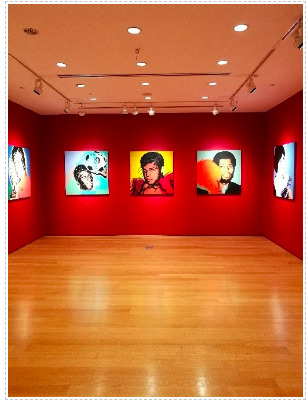
The second artist we looked at was Yves Klein and his masterwork Barbara, 1960. This monochrome is an exceptional example from Yves Klein’s ground-breaking Anthropométries series. Executed in 1960, the painting is the result of the artist covering his nude female models in his signature International Klein Blue (IKB) pigment and choreographing their movements as they imprinted their bodies upon the paper and canvas support. In this work, the female form appears to take flight, contorted and disoriented, it morphs into an abstract arabesque. Klein exhibited his monochromes for the first time at the Galleria Apollinaire in Milan, during 1957. Very important in Klein’s artistic career was the friendship with Lucio Fontana. Fontana was also the first buyer of Klein’s monochrome paintings.
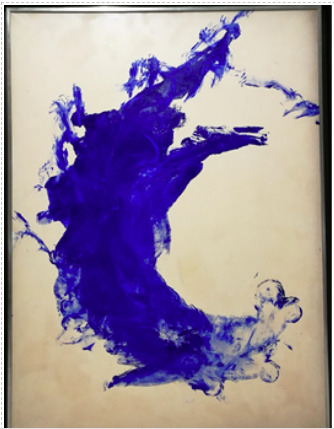
At Sotheby’s we saw many incredible works of art, including two beautiful American masterpieces that were completed in the same time period as Warhol’s work that we saw at Christie’s. The first one we looked at was by de Kooning, Untitled XXII, 1977, from a private collector. Willem de Kooning was a Dutch-American abstract expressionist artist. He was born in Rotterdam in the Netherlands and moved to the United States in 1926 and become an American citizen in 1962. This piece was completed during the time period when de Kooning was living in East Hampton and had recently returned to his passion for painting after experimenting with sculpture. Untitled XXII belongs to an explosive outpouring of creativity that produced an illustrious body of large-scale, color-drenched canvases that rank among the most iconic achievements of de Kooning’s decades-long career. Famous for his relentless working and reworking of canvases in the 1950s, de Kooning demonstrates a confidence and urgency within the composition of Untitled XXII that is as affecting today as it was when it was first exhibited in 1978. Similarly scaled abstract masterpieces from 1977 belong to esteemed private collectors and significant museums worldwide, including The Stedelijk Museum in Amsterdam, The Museum of Modern Art in New York, and The Menil Collection in Houston. For its sheer force of painterly conviction, tactile physicality of its muscular gesture, incandescent lyricism, and eye-wateringly dazzling colors, Untitled XXII ranks among the most irresistible paintings of de Kooning’s output.
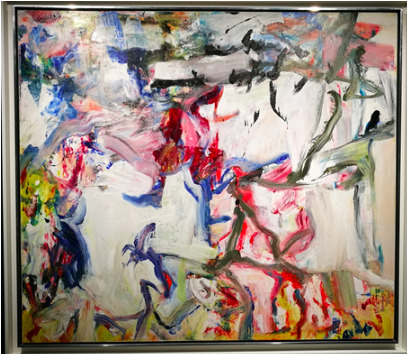
Another work of art that we discussed during the Sotheby’s tour was a painting by Julie Mehretu. Born 1970 in Ethiopia, she is a contemporary visual artist, known for her multi-layered large scale paintings of abstracted landscapes. Her paintings, drawings, and prints depict the cumulative effects of urban sociopolitical changes through the landscape’s alteration of architecture, topography, and iconography. The painting that we looked at during the tour is titled Rise of the Supremacists, executed in 2001, and was completed using ink and acrylic on canvas. This masterpiece is a provocative work of abstract hieroglyphic symbolism and architectural visual vocabulary. Through this pictorial language, Mehretu superimposes marks on an intricate blueprint, with gesture and geometry calling for attention and recognition. Her graphic explorations of space attempt to articulate the power structures and methods of mapping that define the contemporary urban landscape, as well as her own place within them. The gravitas of her conceptual ideology coupled with the skill and dexterity of her mark-making, as magnificently exemplified by the present work, have established Mehretu as a modern master and uniquely articulate voice of a socially, culturally, and politically wary generation.
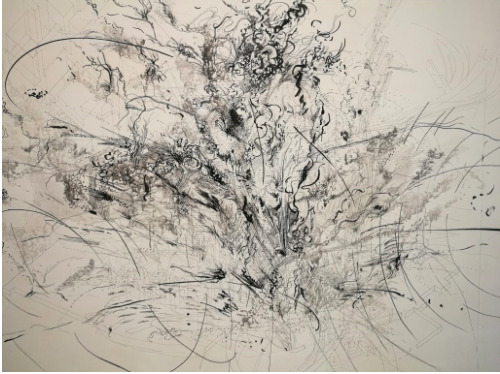
In addition to the contemporary art that we looked at during these tours, we also saw impressionist and modern art. From the Christie’s Collection of Terry Allen Kramer, we saw two masterpieces: Buste d’Homme by Pablo Picasso, and Jardin et poulailler chez Octave Mirbeau, Les Damps by Camille Pissarro. Terry Allen Kramer was a collector, philanthropist and producer, a five-time Tony Award winner, who had a remarkable collection of fine art, including an outstanding grouping of Impressionist and Modern works. Pablo Picasso painted Buste d’Homme during 1968, the male figure in the painting is one of the artist’s famed mousquetaires. During the last decades of his life, Picasso represented himself in his art in the guise of the adventurous, virile musketeer. Serving as the artist’s signature, Picasso employed these male figures to express his own inner life. Unlike many of his comrades, here the musketeer is sporting a plumed metal helmet and his eyes reflect Picasso himself and the artist’s famed mirada fuerte. While, with Camille Pissarro we saw a luxuriant vision of a garden in late summer. Pissarro painted this work in September 1892, during two–weeks spent at the country home in Les Damps in northern France. This work presents a kaleidoscopic vision of color heavily built up from a myriad of tiny touches of complementary hues creating a beautiful visual effect.
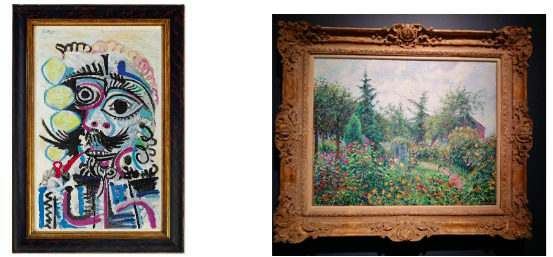
Like Christie’s, Sotheby’s is also home to works by Picasso and Pissarro. Sotheby’s holds a unique collection of Picasso’s paintings and ceramic work from Marina Picasso. Marina is Pablo Picasso’s granddaughter and is selling one of the most extensive collections of the artist’s ceramics. Helped by Sotheby’s, Marina is exhibiting a remarkable group of plates, tiles, vases and other small sculptural figures that her grandfather made between 1947 and the late 1960s. Picasso created ceramic works when he spent his summers on the Cote d’Azur in the South of France. He was inspired to create these during earlier trips to the Riviera while observing the clarity of the light and the bright Mediterranean colors.
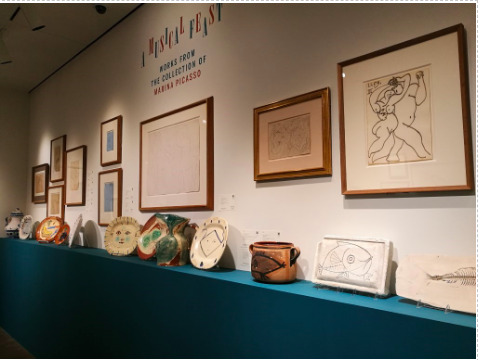
Another important post-impressionist artist that we looked at during our Sotheby’s tour was Paul Signac. When Signac first traveled to the city of Istanbul in the spring of 1907, he was struck by the grandeur and history of the place, and by the unique quality of light and color that filled the ancient city. The artist returned to France with a series of tantalizing canvases on the subject, the largest and most flamboyant of which is La Corne d’Or (Constantinople) in which the city’s skyline is easily recognizable in the background, with the famous minarets of the Hagia Sophia an unmistakable silhouette on the horizon. This ethereal vision, which floats in a miasma of delicate pinks and purples, is framed to either side by an array of boats and ships rendered in vibrant colors that suggest the energy and bustling activity of the modern city. The brilliant luminosity of the composition is typical of Signac’s late style and is wonderfully effective here in paying homage to the historical legacy and richness of the city whilst bringing a fresh vivacity to its portrayal, recalling the heady visions of his prior European expedition.
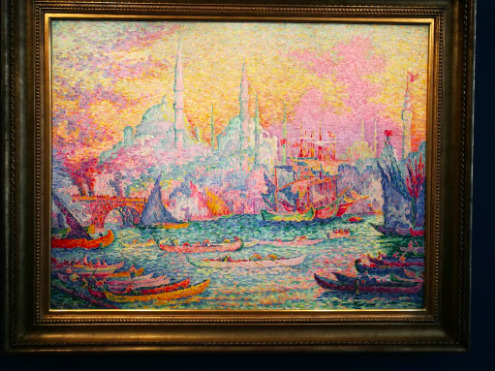
Both of these incredible auction houses have beautiful and significant collections that vary in styles and time periods of art. These tours offered unique insight into both Christie’s and Sotheby’s collections, and thanks to our tour guides we were able to get a deeper and more thorough understanding of the auction houses’ world.
